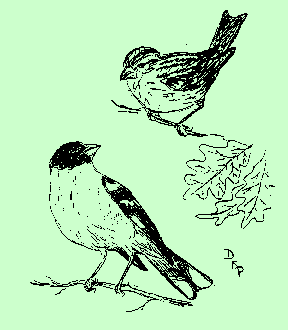|







|
. |
Black-Headed Grosbeak
 The Black-Headed Grosbeak (Pheucticus melanocephalus) is a native of
the West and a close relative of the Rose-Breasted Grosbeak of the Eastern
states. He may be found anywhere from eastern Nebraska to California, and
from British Columbia south to the plateau of Mexico. It winters mainly in
Mexico. Habits of the two species are similar, and where their ranges
overlap, they may hybridize.
The Black-Headed Grosbeak (Pheucticus melanocephalus) is a native of
the West and a close relative of the Rose-Breasted Grosbeak of the Eastern
states. He may be found anywhere from eastern Nebraska to California, and
from British Columbia south to the plateau of Mexico. It winters mainly in
Mexico. Habits of the two species are similar, and where their ranges
overlap, they may hybridize.

 The male has a rusty breast and collar, yellow belly, black head, boldly
marked black and white wings, and large pale bill, making it a striking
bird. In flight it shows black and white wing and tail pattern, and cinnimon
rump. The female is largely brown and streaked, the breast washed with light
brown (usually), and lightly streaked on sides.
The male has a rusty breast and collar, yellow belly, black head, boldly
marked black and white wings, and large pale bill, making it a striking
bird. In flight it shows black and white wing and tail pattern, and cinnimon
rump. The female is largely brown and streaked, the breast washed with light
brown (usually), and lightly streaked on sides.

 The nest is usually loosely constructed, clumsily built of fine twigs, weed
stems, and lined with fine roots and dry grass. It is often such a thin cup
of rootlets and grass that the eggs can be seen through the bottom. It is
built in trees or shrubs of open woodlands, orchards or streamside thickets
from five to twenty feet above the ground. The male helps to build the nest,
and both parents incubate the three or four bluish eggs spotted with brown.
The nest is usually loosely constructed, clumsily built of fine twigs, weed
stems, and lined with fine roots and dry grass. It is often such a thin cup
of rootlets and grass that the eggs can be seen through the bottom. It is
built in trees or shrubs of open woodlands, orchards or streamside thickets
from five to twenty feet above the ground. The male helps to build the nest,
and both parents incubate the three or four bluish eggs spotted with brown.

 The Black-Headed Grosbeak has a rollicking song, like that of the Robin and
Western Tanager. As John Burroughs writes, "It is a very rare occurrence
for a bird to sing while on the nest, but several times I have heard the
Black-Headed Grosbeak do it. I saw the grosbeak mother singing her lullaby
as she sat on her eggs. It looked to me so like a human mother's love. How
this bird took up such a custom I do not know, for birds are very cautious
about attracting attention to the nest."
The Black-Headed Grosbeak has a rollicking song, like that of the Robin and
Western Tanager. As John Burroughs writes, "It is a very rare occurrence
for a bird to sing while on the nest, but several times I have heard the
Black-Headed Grosbeak do it. I saw the grosbeak mother singing her lullaby
as she sat on her eggs. It looked to me so like a human mother's love. How
this bird took up such a custom I do not know, for birds are very cautious
about attracting attention to the nest."

 Quoting from "Out of Doors in the West", by J. H. Paul, "The male is a
brilliant songster, also a model parent, taking his turn on the nest in the
absence of his mate. The song is superb -- a powerful, melodious succession
of clear, rich, rolling notes -- one of the most varied and exquisitely
finished and musical of birds songs. It has a swinging rhythm and clearness,
characteristic of grosbeak songs, but is smooth and rounded, and its highest
notes are dwelt on and trolled over with rare tenderness, repeated, not as
the thrasher's notes are repeated, but with the enjoyment of an artist
consciously perfecting his work." This song has an invigorating robin-like
quality and the melody is rich, pure and sustained."
Quoting from "Out of Doors in the West", by J. H. Paul, "The male is a
brilliant songster, also a model parent, taking his turn on the nest in the
absence of his mate. The song is superb -- a powerful, melodious succession
of clear, rich, rolling notes -- one of the most varied and exquisitely
finished and musical of birds songs. It has a swinging rhythm and clearness,
characteristic of grosbeak songs, but is smooth and rounded, and its highest
notes are dwelt on and trolled over with rare tenderness, repeated, not as
the thrasher's notes are repeated, but with the enjoyment of an artist
consciously perfecting his work." This song has an invigorating robin-like
quality and the melody is rich, pure and sustained."

 "The services to agriculture are so great that their destruction is not to
be considered." This bird consumes about 66% animal and 34% vegetable food;
of the latter, a large proportion consists of weed seeds. The animal food
consists of injurious insects including the coddling moths, canker worms,
flower beetles, and scale insects.
"The services to agriculture are so great that their destruction is not to
be considered." This bird consumes about 66% animal and 34% vegetable food;
of the latter, a large proportion consists of weed seeds. The animal food
consists of injurious insects including the coddling moths, canker worms,
flower beetles, and scale insects.

 The warble of the Black-Headed Grosbeak is heard from April or early May
until July.
The warble of the Black-Headed Grosbeak is heard from April or early May
until July.
-- by Marie L. Atkinson
|
|

